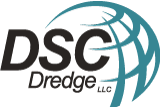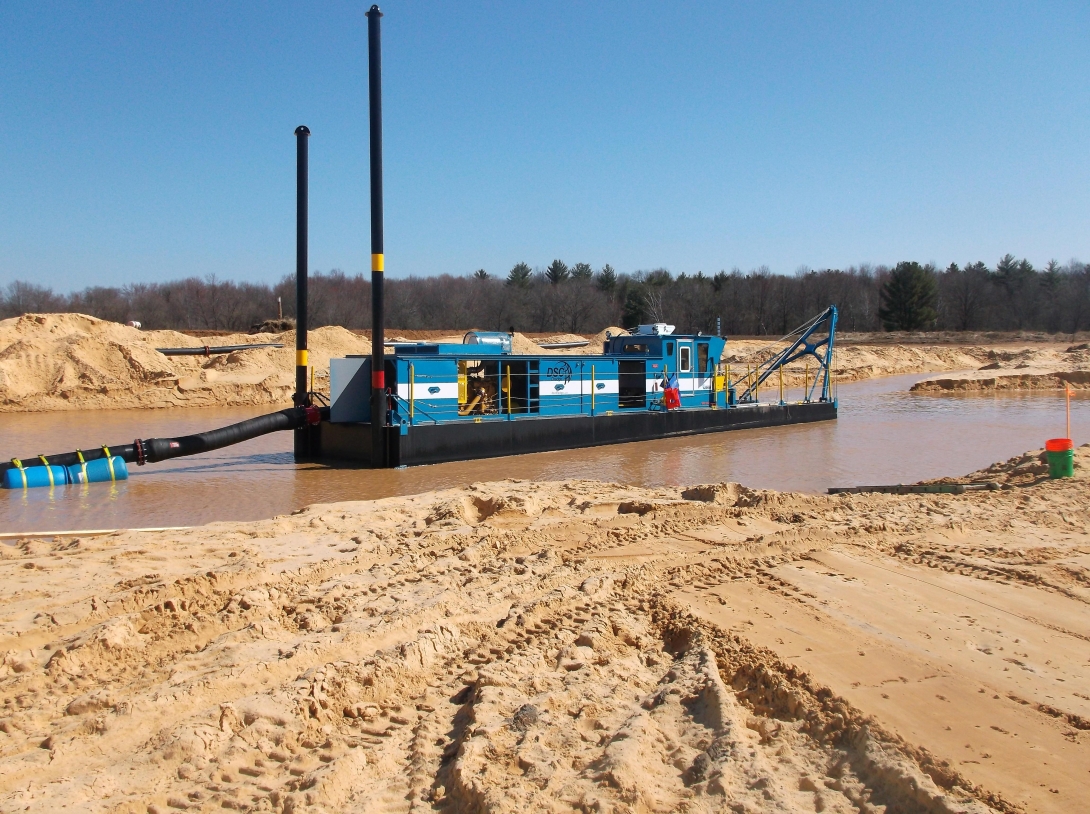Challenge
Coulee Frac Sand encountered water 6 feet below ground level as it mined frac sand.
Solution
A DSC Wolverine Class hydraulic dredge now mines the sand and sends it to an onsite processing plant.
Coulee Frac Sand, based in La Crosse, Wisconsin, recently took delivery of a 10-inch Wolverine Class cutter suction dredge by DSC Dredge, LLC. The dredge, which was designed and manufactured at DSC Dredge’s Greenbush, Michigan, facility, is mining sand at the PineCrest Mine on the site of Doc’s Bunkhouse campground, near the town of Merrillan in central Wisconsin. As groundwater was encountered 6 feet below ground level, the company proposed mining the material through the use of a hydraulic dredge, with an onsite processing plant. The operation has been designed to return all dredged water back to a man-made lake. Coulee Frac Sand anticipates the dredging of approximately 1.6 million tons of sand will be complete in 2 to 3 years, at which time the site will be reclaimed as a manmade lake for recreational use by Doc’s Bunkhouse campground patrons.
This dredge project is unique in that it started at a site that has no natural flowing source of water. All of the water used by the operation is sourced from groundwater and precipitation. The two main components to the mine include the Wolverine dredge and an onsite wet processing plant with screens, separators, hydrocyclones, and a hydrosizer to separate and dewater oversize, coarse and fine sand from unusable ultrafines.
The company readied the site for the Wolverine dredge by excavating a quarter-acre starting pit 12 feet deep (4 feet below the water table) into which the Wolverine has been placed. The initial job for the dredge is to enlarge this area to include 2.7 acres, at a depth of approximately 24 feet deep (16 feet below the water table), and then excavate an artificial river bending toward the processing plant. The processing plant is currently being built, so the initial dredged material is being placed in a temporary spoil site at this time, with the return water flowing back through stand pipes to the lake. Once the processing plant is up and running, the dredge will pump material and water directly to the plant, where the material (comprising medium-grade, non-compacted brown sand) will be separated and readied for transport offsite. The mine is designed so that return water, stockpile drainage and stormwater will flow into the artificial river and back to the lake in a closed loop, thus not drawing any water from surrounding sources other than on the premises. This mine is a win-win for Coulee Frac Sand and for the region in that it is yielding a valuable natural resource, which is being harvested in an environmentally friendly manner. At the end of the mine’s life, reclaimed land totaling approximately 21 acres will become a recreational lake that will be enjoyed by current and future generations.
The DSC Wolverine dredge is ideal for this project because it has the cubic-yard capacity to feed the processing plant with all of the sand it will for its daily requirements. With the Wolverine’s versatile dredging depths (it can dredge up to 25 feet below the surface and offers a 10-inch discharge configuration, which allows particle clearance of up to 6 inches), it is able to comfortably excavate in the shallow conditions now present at the PineCrest mine, and will easily continue to the goal depth of 24 feet once the mining lake and river open up.
The Wolverine is powered by a 440-horsepower Caterpillar C13 ACERT diesel engine. The cutterhead, designed with six cast-steel smooth blades, is attached to a variable-speed, reversible, hydraulic cutter motor manufactured by Kawasaki. The dredge pump, a J30 Metso Minerals/Thomas Simplicity series, is rated for 200 feet of total discharge head at 4,200 gallons per minute. Five hydraulic winches, rated with a 4,500-pound line pull capacity, are used to swing the dredge, lift the spuds and lift the ladder.






